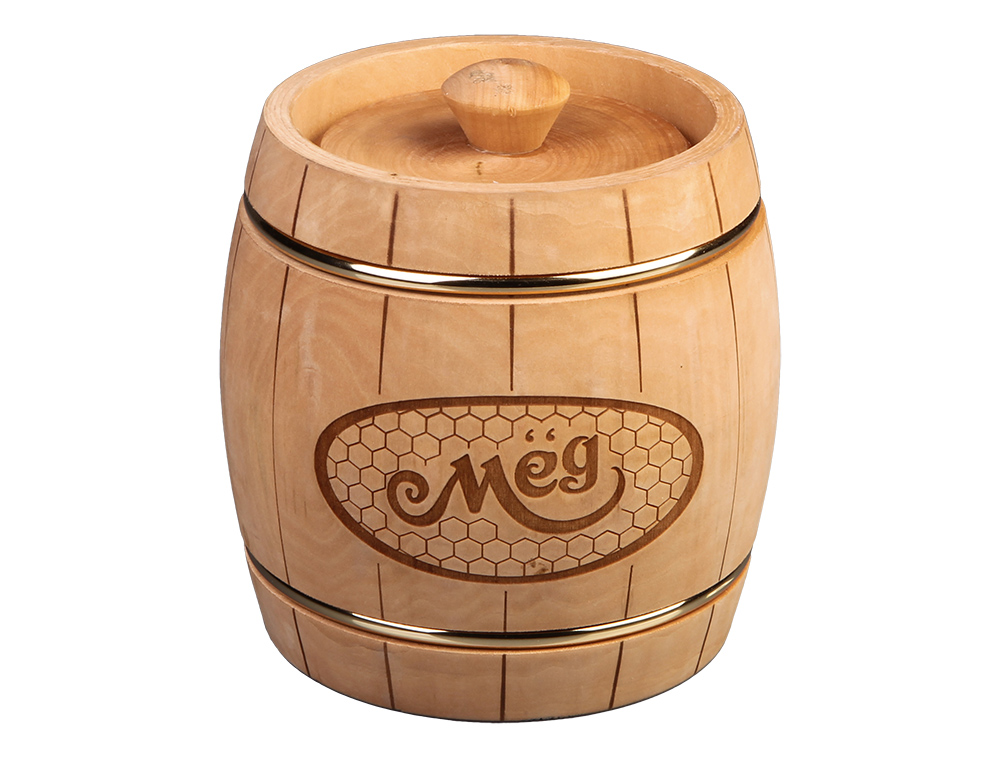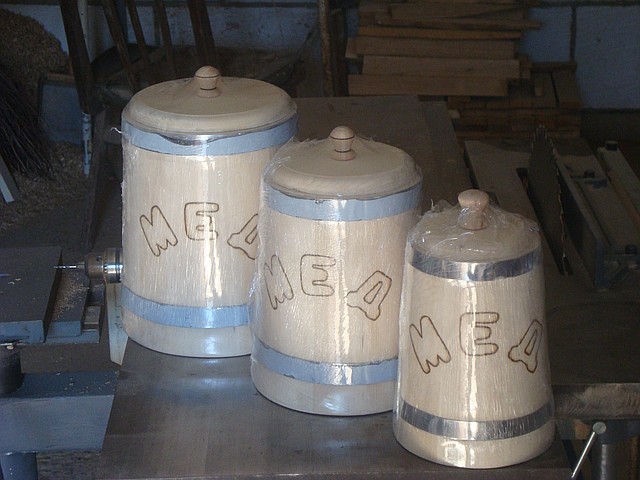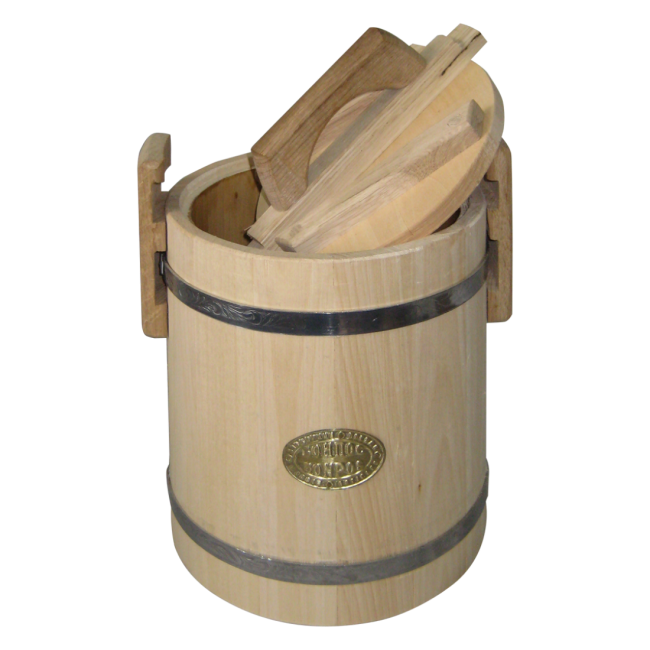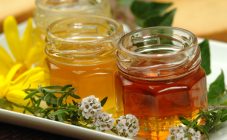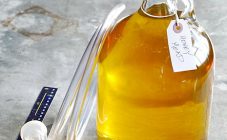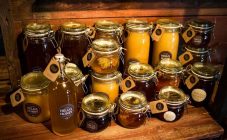Content:
The best utensils for storing honey are containers made from deciduous wood. The best option is linden. The honey collected by wild bees from linden flowers and stored in the hollow of this tree is considered one of the most valuable. Linden barrels for honey, even with minimal carpentry knowledge, are quite simple to make. The wood of this tree is soft, dense and "juicy" - it is easy to turn, perfectly cut and planed.
Linden honey keg
Boards for the barrel are planed, driven through a thickness gauge. The size of the slats is 20 * 140 mm. The boards are cut along the grain, not across the grain. Using a circular, or trimming. When cutting, you need to use a goniometer, because the cross-section of the planks must have the shape of a trapezoid.
Each plank should be sanded to remove unevenness and grain in the wood. Then the planks are laid out in a circle, with narrow sides inward. They are either glued together or steamed and bent, securing only with hoops. How to glue:
- The strips are laid out with the outside on tape or electrical tape.
- PVA glue is squeezed out between the sides with a sausage.
- Spread the glue with a brush. They work quickly so that the glue does not set.
- Raising the ends of the scotch tape, collect the barrel, put metal clips on it so that the straps are held tightly. The adhesive will come out liberally - this is normal.
- After half an hour, you can already start processing the workpiece on a lathe.
Machining on the machine:
- For further fastening of the bottom, a groove is machined along the inner perimeter of the workpiece.
- A round billet for the bottom of the same thickness (in this example 20 mm) is marked out. Stitch the marked circle around the outer perimeter.
- The inner side of the bottom is immediately sanded, since after landing on the barrel it will be difficult to reach it.
- The bottom is also planted on the workpiece with glue.
- The workpiece is allowed to dry well. Can be left overnight.
- Now you can process the outside of the keg. The sides are ground on the machine, giving the desired shape, usually round.
- After that, they are carefully polished. You can make decorative notches.
- The inner surface of the keg is treated in the same way. You should not thin the walls too much, just align them.
- The end is leveled and a seat under the cover is made. The inner and end surfaces are ground. The top of the keg is covered with mastic.
- The workpiece is ready, you can cut it off. The bottom is sanded from the outside.
Next, a cover is made:
- An octagonal workpiece with a pre-drilled hole of 12 is clamped in the chuck of the machine, pressed with a nut. The workpiece is given a round shape.
- Grind the seat on the workpiece along the outer perimeter, periodically applying the barrel itself so that the lid fits both easily and tightly.
- When the fit is done, a small notch is made inside the lid so that it is further convex.
- The lid blank is turned over, and the outside of the lid is processed in the same way. Grind off excess, grind with several types of sandpaper, apply mastic.
- The handle for the lid is machined separately, in the form of a bolt with a convenient rounded tip. The excess wood is ground down, periodically checking the diameter so that it matches the hole in the lid.
Read more about making a keg - on the video
How to make a wooden honey barrel with your own hands
A real honey barrel is made without glue. The parts fit together so tightly and are held in place by the hoops that there is no hint of a gap. Linden is the best material for barrels in which caviar, pickles or honey are planned to be stored. Barrel making instructions:
- You need to decide on the type of container: a barrel for honey or a tub. The barrel has a uniformly "pot-bellied" shape, the tub - slightly widens towards the base.
- Rivets are made - this is the basis of the product. They are rectangular boards specially fitted to the shape of the future barrel or tub. For the latter, they will have the shape of a strongly elongated isosceles trapezoid, for a barrel, they will be convex in length.
- Make sketches of rivets, bottoms and a construction drawing based on the design and required dimensions.
- The number of rivets must be calculated. This is done according to the formula: 2 * Pi number * R / W. In this formula, W is the width of the riveting, and P is the radius of the bottom (for products with equal sides) or the middle (for products with convex sides).
- Rivets are made from logs and require some skill. The sides must be even. You can buy ready-made boards of the required thickness. It is optimal to make rivets from freshly cut wood, then dry at normal summer outdoor temperatures for 3 months.
- Three hoops are made of stainless steel. They are cut from strips of steel and fastened into hoops with rivets. The width of the hoops depends on the dimensions of the product: up to 25 liters - 3 cm, 25-50 liters - 3.6 cm, up to 100 liters - 4-4.5 cm. The thickness of the stainless steel is 1.6 mm.
- Assembling the barrel. 3 rivets are inserted into the smallest hoop, at the same distance. They are fixed with special clamps. Other rivets are placed between them, then the next hoop is put on. Working with a wooden block placed between the barrel and the hammer, they achieve a tight shrinkage. The resulting barrel is immersed in boiled water for half an hour. Then they put it, wrap the upper edge with a rope, fix the ends of the rope in a special device and begin to tighten. As soon as the desired bend is obtained, other hoops are put on.
- Insert the bottom piece by slightly loosening the staples and then securing them again.
- Oak barrels are fired inside to give the drinks a nuance of taste, and linden barrels are carefully treated with natural wax to give airtightness and create more natural conditions for storing honey.
Tubs for honey: what is it, what tree is it made of
A wooden linden barrel of honey is a harmonious union of two related natural natural materials. The shelf life of honey in contact with lime wood tolerant to it is not limited! Tub - a container similar to a barrel, only a slightly different shape. It can be made from the same material, the pros and cons are almost the same. The only caveat is that the tub cannot be kept on its side, while the barrels fit perfectly in a horizontal position.
Wood for the manufacture of barrels and tubs: oak, spruce and pine, cedar, linden, aspen, larch, carp, beech, birch. For storing honey, the best options are linden, aspen and rank. Hardwoods are also suitable: poplar, alder, willow. Although some experts criticize them, giving preference exclusively to linden wood. But an oak barrel, so prized for storing drinks and salting, will not work categorically: the honey in it will darken. It is also better to exclude tubs made of coniferous wood: in them honey will acquire a resinous smell.
How honey is stored in a tub
A barrel or tub of honey should be kept in a clean, dry (humidity - up to 60%) and cool room. The barrel should be well finished with beeswax and covered with a tight, air-tight lid. The container should not be exposed to sunlight, the room should not be hot, dark, with a stable temperature without changes.Optimum temperature: from -6 to + 20 ° С and it is better to stick to the golden mean.
Under the right conditions in a linden tub, honey can retain its characteristics indefinitely. It will not change in composition, taste, appearance.
Pros and cons of tubs
For storing honey, in addition to barrels and tubs made of natural wood, can be used:
- glass containers,
- ceramic glazed,
- aluminum, tin with food lacquer coating inside,
- stainless steel flasks.
Advantages of linden tubs:
- Gives products unobtrusive, very pleasant flavoring shades, harmoniously combined with the taste of honey.
- Ease of manufacture. Linden lends itself well to processing. It is juicy, light and pleasant material.
- Beautiful wood. Of course, this is a matter of taste, and one can argue which is more beautiful: oak, cherry or walnut. But linden, even without being included in the top five of the most beautiful types of wood, has a pleasant look. The color of the wood is fresh, white with pinkish tints and a harmonious grain structure. Linden products are light, joyful, light.
- High density of wood, which protects honey well from external influences.
- Linden honey barrel can be kept empty for a long time, the wood gives a low percentage of shrinkage, and the product does not lose its insulating properties. For storage, they do not need to provide special conditions.
- Linden barrels do not need to be soaked before use, like oak barrels.
- And finally, the elongated and slightly truncated shape allows honey to maintain its natural structure.
The disadvantages of wooden utensils for honey are due to purely economic issues:
- such containers are more expensive than glass or plastic,
- when choosing them, you need to "be in the know" so as not to purchase a poorly made barrel,
- usually it is convenient to store in them large amounts of honey, which not everyone can afford.
Nevertheless, the traditions of cooper craftsmanship have recently experienced a rebirth. Environmentally friendly natural materials and products are highly valued, which is why wooden tubs and barrels for honey are increasingly bought and sold more often. And if this valuable household item is made by hand, it will bring even more pleasure.
